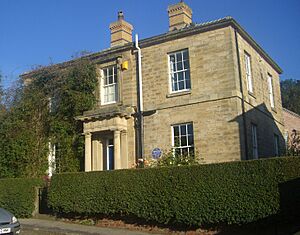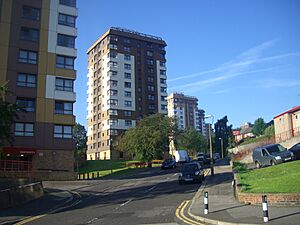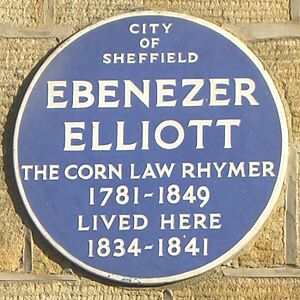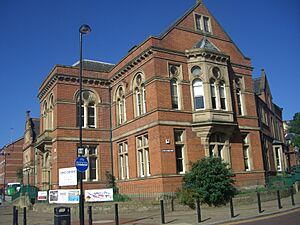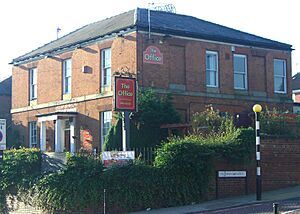Upperthorpe, Sheffield facts for kids
Quick facts for kids Upperthorpe |
|
|---|---|
| Metropolitan borough | |
| Metropolitan county | |
| Region | |
| Country | England |
| Sovereign state | United Kingdom |
| Post town | SHEFFIELD |
| Postcode district | S6 |
| Dialling code | 0114 |
| Police | South Yorkshire |
| Fire | South Yorkshire |
| Ambulance | Yorkshire |
| EU Parliament | Yorkshire and the Humber |
| UK Parliament |
|
Upperthorpe is a part of the big city of Sheffield, England. It is located about 1.2 miles (2 kilometers) west of the city centre. This area is mostly made up of homes where people live. It is surrounded by other areas: Walkley to the north, Crookes to the west, and Netherthorpe to the south.
Contents
A Look Back: Upperthorpe's History
No one knows exactly when people first settled in Upperthorpe. The name "Upperthorpe" tells us a bit about its past. "Thorpe" is an old Danish word meaning "a small farm or village outside a main town." The first part of the name comes from an old English word for a "cooper," someone who makes barrels. This suggests the village started around the 9th or 10th century, when both Viking and Old English words were used together.
By the year 1383, the area was called Hoperthorpe. Over many years, this name slowly changed to Upperthorpe.
Early Industries and Water Supply
In the mid-1500s, tanning became a big business in Upperthorpe. Tanning is the process of turning animal skins into leather. The Rawson family, a very old family from the Hallamshire area, set up tanning pits here. Their business grew, and they also opened tanneries in nearby Walkley and Philadelphia. However, by the 1800s, this industry started to struggle. It eventually couldn't compete with larger tanning areas like Walsall and Leeds.
Upperthorpe was also important for Sheffield's water supply. In 1712, two men, John Goodwin and Robert Littlewood, were chosen to bring water from springs in Upperthorpe to the centre of Sheffield. They used pipes for this. By 1737, the first of several reservoirs was built here. But as Sheffield grew, the water from Upperthorpe wasn't enough. So, new reservoirs were built in Crookesmoor in the late 1780s.
Growth and Important Buildings
For a long time, Upperthorpe was mostly a farming village. The first sign of Sheffield town growing closer was when the Sheffield Royal Infirmary hospital was built on Upperthorpe Meadows. This was about half a mile outside the town back then. The hospital opened in 1797 and got its clean water from a stream called Spring Vale. This stream supplied the hospital until 1861.
By the 1820s, Upperthorpe was becoming a "pleasant and popular place to live." In 1826, John Blake, a very important local businessman, built Upperthorpe Villa. This stone house with a porch is at 22 Blake Grove Road. It is still standing today and is a listed building, meaning it's protected for its history. Nearby Blake Street, which is very steep, and the Blake Hotel public house are named after John Blake. He sadly died in the cholera outbreak of 1832. Blake Street is one of the steepest residential streets in England!
Ebenezer Elliott, a famous poet known as the Corn Law Rhymer, lived at Upperthorpe Villa from 1834 to 1841. There is a blue plaque on the building to remember this.
More houses were built in the late 1840s. The Birkendale Freehold Land Society built many detached and semi-detached houses. Each house had a large garden. These homes were mainly for skilled workers in the steel industry, like makers of scissors, spring knives, and cutlery. Today, the Birkendale area is a conservation area with 65 houses. Sir Stuart Goodwin, a very important industrialist who started the Neepsend Steel and Tool Corporation, was born at 120 Upperthorpe. He was a big supporter of Sheffield and helped fund the city's Christmas lights for many years. He also funded the Goodwin Sports Centre. A fountain in the Peace Gardens remembers him.
Modern Changes in Upperthorpe
Upperthorpe has changed a lot over the years. Many new buildings were put up in the 1950s, 1960s, and again in the 1980s. However, some older, traditional houses still remain around Daniel Hill, Blake Street, and Birkendale. There's also a small historic area with the old public baths and library from the 1800s.
Between 1959 and 1961, seven tall tower blocks were built on Martin Street and Oxford Street. These blocks have 12 floors of homes and are named Wentworth, Adelphi, Martin, Burlington, Bond, Albion, and Oxford. They were updated between 1993 and 1996. After the big changes in the late 1960s, a green space called The Ponderosa was created next to the tower blocks. This used to be where old terraced houses stood.
The Kelvin Flats
The Kelvin Flats were built in 1965 on Infirmary Road. This was a huge and modern housing project, similar to the Park Hill Flats. It had two 13-storey blocks with 948 flats. These blocks had wide walkways, sometimes called "Streets in the Sky." They were named Edith Walk, Woollen Walk, Portland Walk, and Kelvin Walk. Even though the Kelvin Flats had some social problems, the people living there had a strong community spirit. In 1992, Sheffield City Council decided to knock them down, which happened in 1995–96. New, more traditional homes were built in their place, along with a small green area called Philadelphia Green Space. This area has old trees and wildlife.
Other Important Buildings
The Upperthorpe Public Library is a historic building in the heart of Upperthorpe. It was built in 1874. The Upperthorpe Baths are right next door to the library and were built in 1895. Since 2003, both the library and the baths have been part of the Upperthorpe Healthy Living Centre, now called the Zest Centre. Besides the library and a swimming pool, the centre has a gym, a café, and rooms for meetings.
Eversley House at 115 Upperthorpe Road is also a historic building. It was built in 1840 as a private home. In 1919, a steel manufacturer named Mr. James Wing gave it to St. Philip's church to be used as community rooms. In later years, the house became a pub. It was first called The Eversley House, then The Moon, and is now known as The Office.
The Sheffield Royal Infirmary hospital closed in the 1980s. It has been updated and is now called Heritage Park, used for offices. The complex includes four buildings: Heritage House, Centenary House, and The Roundhouse, which were all part of the old hospital. The fourth building, Victoria House, is new and was built around 1990.
What Can You Find in Upperthorpe?
Upperthorpe has a medical centre called the Upperthorpe Medical Centre on Addy Street. There are no churches directly in Upperthorpe, but people go to churches in nearby Netherthorpe or on the Langsett estate.
You can find two pubs in the area: The White Rails and The Office. The Upperthorpe Hotel closed in 2009 and is now flats and shops. There is a small shopping area on Upperthorpe Road and a large Tesco supermarket where the old Sheffield Royal Infirmary used to be.
There are no schools right in Upperthorpe. The old Upperthorpe primary and infant school closed in the 1990s. Apartments were built on that site. Children now go to schools in Netherthorpe or Walkley.
Upperthorpe in Numbers
According to the 2001 census, Upperthorpe has a population of 2,960 people. A large number of the homes in Upperthorpe are flats or apartments, and many of these are rented from the local council.




